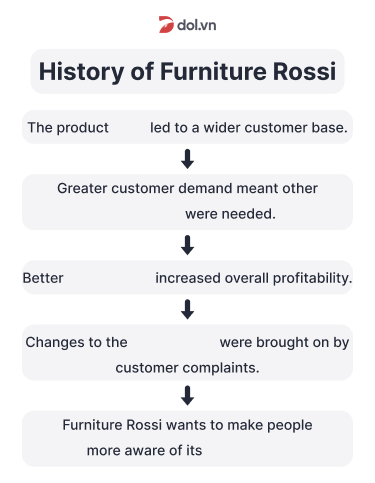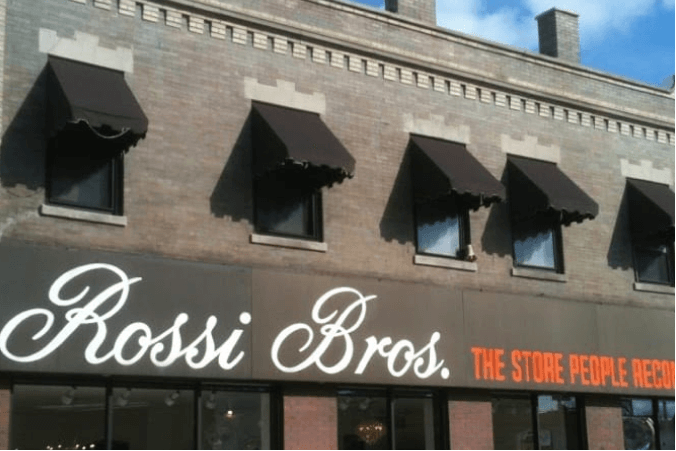Tutor:
Well James, I've had a look over your case study and for a first draft, it looks promising
James:
I have to be honest, when you told us we had to write about a furniture company, it didn't sound like the kind of thing that would interest me, but since then. I've changed my mind .
James:
Well, as you know. Furniture Rossi is an Australian company, still comparatively small compared to some of the high street stores, but it's got plans to expand into foreign markets. So I choose it for that reason. It's going through a transition - it's a family-run business aiming to build a global brand.
Tutor:
All right, and you've made that clear in your writing. One thing, though, that I think you've overlooked is why Luca Rossi started a furniture company here in Australia in the first place.
James:
Well, he'd just got an arts degree, hadn't he? And people were trying to talk him into an academic profession but he wanted a practical job - something he thought would be more satisfying in the long run. His grandfather had been a craftsman. He'd made furniture in Italy and he'd passed this skill on to Luca's father, and well, Luca thought he'd like to continue the tradition.
Tutor:
Yes, that was the motivation behind his decision. And what was it, do you think that gave Furniture Rossi a competitive edge over other furniture companies?
James:
I wouldn't think it was price. It's always been at the higher end of the market, but according to my research, it was to do with the attitude of the employees - they were really focused on giving good customer service.
Tutor:
Yes, Luca Rossi insisted on that. Their promotional campaigns also emphasised the fact that the wood only came from Australian forests, but that was the case with their rivals, too, so it wouldn't have made them stand out. OK, we'll have a careful look at the content of your case study in a minute, but I just want to make a general comment first, before you start writing your second draft.
Tutor:
Yes, what I'd like to see more of is your opinion, a bit more critical thinking, rather than the bare facts. But it's good to see you've been careful with your referencing this time.
James:
Thanks. And I read and re-read my work so I’m pretty sure there aren’t any errors with the language.
Tutor:
Yes, it’s fine. Oh, but there’s one other thing I could probably mention at this point.
Tutor:
Well, at the end of term, you'll also be giving a presentation - also on Furniture Rossi.
James:
Yes, I haven't given it much thought yet.
Tutor:
Understandably. But, while you're writing the case study, I'd recommend you think about what kind of information would be suitable to use in your presentation Remember - the last time you gave a presentation on a company, you spent a considerable part of the time providing the audience with financial data, but they probably needed to hear more about company strategy.
James:
Yes, I did concentrate rather too much on the figures. I'll make sure there's a balance this time.
Tutor:
OK, so let's just think about the content of your case study - the history of Furniture Rossi. I see here in paragraph four you're talking about how Luca Rossi raised the capital for his new business venture - and then you're talking about the customer base growing much wider - but what was it that prompted this growth?
James:
Well, that was to do with the quality of the furniture products that the company was selling. People loved that it was all hand-made and would last.
Tutor:
And because demand from customers kept growing?
James:
Well, then Rossi needed to take on more craftsmen so they could make sure the orders were ready on time, and then, he also had to set up two new warehouses to make distribution quicker.
Tutor:
Yes. And from there, the company really grew. But think what happened next. They started looking at ways to increase their profits and called in a consultant. And what he saw immediately was that the infrastructure was completely outdated - they were paying three full-time admin staff just for data-entry. So he recommended they upgrade their software programs and that, in turn, cut operational costs and just speeded everything up.
James:
I'm surprised they didn't get on to that earlier, but I suppose Luca Rossi was more interested in the design aspect, rather than the finance side of things.
Tutor:
Yes, I imagine that's why he eventually turned the day- to-day running of the company over to his son. And in fact, it was the son, Marco, who persuaded his father to move on from traditional television advertising and go online instead.
James:
I guess that's the best way to reach people.
Tutor:
It can be, but initially, customers actually complained.
Tutor:
Well, some users found it hard to navigate their way around the website - so they were getting frustrated and giving up. So then the company called in a professional to improve it.
James:
I see. He must have done a good job. They've had a continuous three-year rise in revenue - so things must be going well.
Tutor:
Indeed. And what of the future?
James:
Well, I probably need to talk about this a bit more in the concluding paragraphs, don't 1? Consumers are already aware of the quality of the furniture, that's for sure, but I think the company is aiming to publicise their values – the fact that they have respect for beauty, durability and functionality, and the environment. A lot of companies are already …

 Nghe thấy "Furniture Rossi is an Australian company"
Nghe thấy "Furniture Rossi is an Australian company" 
 Nghe tiếp thấy "....it's got plans to expand into foreign markets. So I choose it for that reason."
Nghe tiếp thấy "....it's got plans to expand into foreign markets. So I choose it for that reason."
 "It's going through a transition - it's a family-run business aiming to build a global brand"
"It's going through a transition - it's a family-run business aiming to build a global brand"

